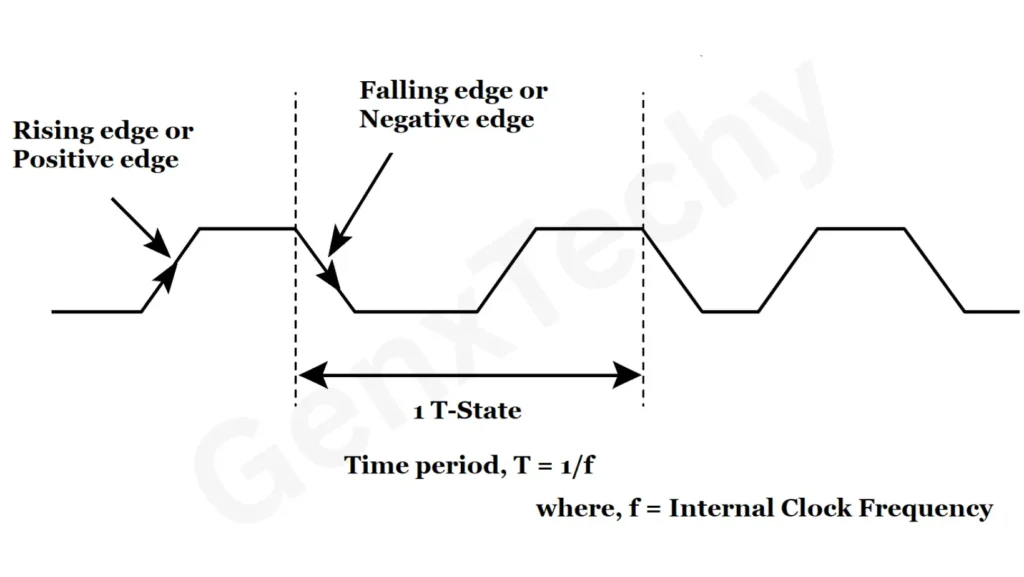Timing Diagram of 8085 Microprocessor
Concept of Instruction Cycle, Machine Cycle and T-State
- The 8085 microprocessor fetches the instruction from the address in the program counter, decodes it, and then executes it. If needed, it fetches extra data before finishing execution.
- Each instruction has two parts: the opcode, which is the command (like ADD), and the operand, which is the data or register the command works on.
- The 8085 executes a program step by step, not all at once. These steps are explained using three terms: Instruction Cycle, Machine Cycle, and T-State.
Instruction Cycle
- The Instruction Cycle is the total time taken by the microprocessor to complete the execution of one instruction.
- An instruction can be simple (like MOV A, B) or more complex (like LDA 2500H).
- Every instruction cycle is made up of a sequence of machine cycles.
Machine Cycle
1. A Machine Cycle is the time taken by the microprocessor to complete one basic operation, such as:
- Fetching an opcode (Opcode Fetch Cycle)
- Reading data from memory (Memory Read Cycle)
- Writing data to memory (Memory Write Cycle)
- Reading data from an I/O device (I/O Read Cycle)
- Writing data to an I/O device (I/O Write Cycle
2. Each machine cycle consists of a fixed number of T-states (clock periods).
T-State (Clock Cycle)
- The T-state is the smallest unit of time in microprocessor operations.
- It is the time period of one clock pulse.
- Each machine cycle is made up of several T-states.
Example:
- If the clock frequency of 8085 is 3 MHz, then:
- Time for one T-state = 1 / 3 MHz = 333 nanoseconds.
- If a machine cycle takes 4 T-states, then total time = 4 × 333 ns = 1.333 microseconds.
T-state required for various machine cycles:
- Opcode Fetch Cycle – usually 4 to 6 T-states
- Memory Read Cycle – 3 T-states
- Memory Write Cycle – 3 T-states
- I/O Read Cycle – 3 T-states
- I/O Write Cycle – 3 T-states
- Interrupt Acknowledge Cycle – 3 T-states
Various possible states of the processor based on the control signals, IO/M’, S0 and S1:
Table 1: Processor States on different control signals
| IO/M’ | S1 | S0 | Processor State |
|---|---|---|---|
| Z (High Impedance) | 0 | 0 | Halt |
| 0 | 0 | 1 | Memory Write |
| 1 | 0 | 1 | I/O Write |
| 0 | 1 | 0 | Memory Read |
| 1 | 1 | 0 | I/O Read |
| 0 | 1 | 1 | Opcode Fetch |
| 1 | 1 | 1 | Interrupt Acknowledge |
Few facts about 8085 microprocessor machine cycle execution:
- The 8085 microprocessor takes four (4) T-states to execute the opcode fetch machine cycle.
- Three (3) T-states to execute the memory and I/O read/write cycles.
- The interrupt acknowledge cycle is similar to the opcode fetch cycle.
- Figure 1 shows the common waveform of the clock signal used in microprocessor systems. The clock signal is a square waveform of high frequency in the range of MHz.
- The rising and falling edge of the clock signal can be clearly seen, as its frequency is very high and time period is correspondingly very low.
- Timing diagram for an instruction is obtained by drawing the binary levels on the various signals of the 8085.
- It is drawn with respect to the clock input of the microprocessor. It explains the execution of the instruction using the basic machine cycles of that instructions.

Fig. 1: waveform of the clock signal
FAQs
What is an instruction cycle in 8085?
An instruction cycle is the total time required by the microprocessor to fetch, decode, and execute one instruction.
What is a machine cycle in 8085?
A machine cycle is the time taken to complete one basic operation like fetching an opcode, reading data, or writing data.
What is a T-state?
A T-state is the smallest unit of time in a microprocessor. It is the duration of one clock pulse.
How are instruction cycle, machine cycle, and T-state related?
- An instruction cycle consists of one or more machine cycles.
- Each machine cycle consists of a fixed number of T-states (clock cycles).
Why do we need timing diagrams in 8085?
Timing diagrams help us understand the exact sequence and timing of operations between the processor, memory, and I/O devices.
What does an opcode fetch cycle mean?
It is the machine cycle in which the microprocessor fetches the opcode (instruction code) from memory.
How many T-states are usually needed for an opcode fetch cycle?
The opcode fetch cycle usually takes 4 to 6 T-states depending on the instruction.
What is the difference between instruction cycle and machine cycle?
- Instruction cycle = execution of a complete instruction.
- Machine cycle = execution of a single basic operation within an instruction cycle.
What is the difference between machine cycle and T-state?
- Machine cycle = several clock cycles grouped to perform one operation.
- T-state = a single clock pulse, the smallest unit of operation.
How many T-states does a memory read cycle take?
A memory read cycle typically takes 3 T-states.
What is the significance of the program counter in the instruction cycle?
The program counter holds the memory address of the next instruction to be fetched and executed.
How can we calculate the execution time of an instruction?
Execution time = (Number of T-states × Time period of one T-state).
For example, if clock frequency = 3 MHz → T-state = 333 ns. An opcode fetch of 4 T-states will take 4 × 333 ns = 1.333 μs.

